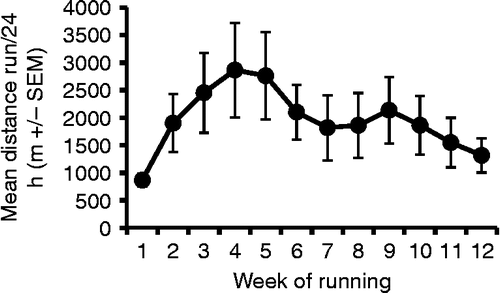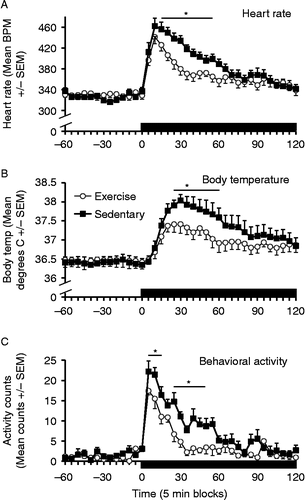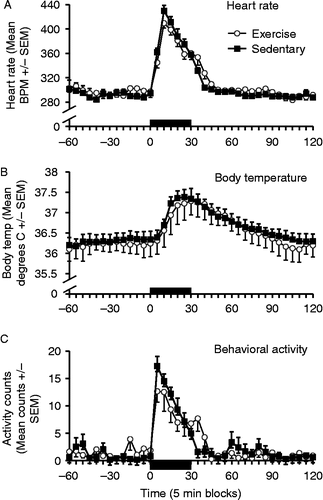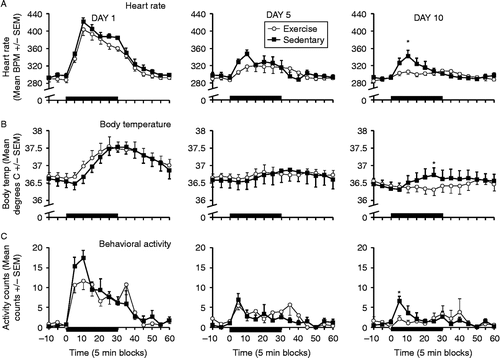Figures & data
Figure 1. Schematic representation of the experimental protocol timeline displaying the order of the three experiments and some of their details.

Figure 2. Mean distance run per 24 h ( ± SEM) calculated weekly over the 12 weeks of the study in rats (n = 8) given voluntary access to running wheels. As is typically observed in Sprague–Dawley rats, the daily average distance run increased initially until the fourth/fifth week of running, and gradually decreased thereafter. Repeated measures ANOVA on mean running distances was significant (p = 0.002), as was the quadratic component (p = 0.048).

Figure 3. Mean ( ± SEM) heart rate (Panel A), body temperature (Panel B), and behavioral activity counts (Panel C) during novel environment (white bucket–black bars on x-axis) exposure in sedentary (black squares) and free-wheel running (open circles) rats (n = 7/group). The solid bar represents the time that the rats were exposed to the novel environment. Significant statistical differences (repeated measures ANOVA) were obtained between exercised and sedentary rats on all three response measures in response to the novel environment (p < 0.05). BPM: beats per minute; Temp.: temperature. Asterisks indicate that the groups were significantly different at the time points spanning the thin horizontal bars (t-tests, p < 0.005, Bonferroni correction).

Table I. Areas under the curve (mean ± SEM) for the heart rate, core body temperature (Temp.), and locomotor activity during stress presentation and recovery from stress for Experiments (Exps) 1, 2, and 3. Exp. 1: acute novel environment stress; Exp. 2: acute noise stress, 85 dB; and Exp. 3: repeated audiogenic stress, 98 dB.
Figure 4. Mean ( ± SEM) heart rate (Panel A), body temperature (Panel B), and behavioral activity counts (Panel C) during acute loud noise exposure (85 dB – black bars on x-axis) in sedentary (black squares) and free-wheel running (open circles) rats (n = 7/group). The solid black bar represents the time that the rats were exposed to noise. BPM: beats per minute; Temp.: temperature. No statistically significant differences were obtained between exercised and sedentary rats on any of the responses induced by a 30-min 85 dB noise session (repeated measures ANOVAs, all p′s>0.05).

Figure 5. Mean ( ± SEM) heart rate (Panel A – top row), body temperature (Panel B – middle row), and behavioral activity counts (Panel C – bottom row) during the first (day 1 – left column), fifth (day 5 – middle column), and 10th (day 10 – right column) loud noise (30 min, 98 dB – black bars on x-axis) exposures in sedentary (black squares) and voluntary exercise (open circles) rats (n = 6/group). The solid bar represents the time that the rats were exposed to noise. BPM: beats per minute; Temp.: temperature. Statistically significant differences (repeated measures ANOVA) were obtained between exercised and sedentary rats on all three response measures on the 10th loud noise exposure (all p < 0.05). Asterisks indicate significant difference between sedentary and exercised groups (t-tests, p < 0.02, Bonferroni correction), at the indicated time points.
